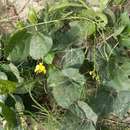Physical Description
(
anglais
)
fourni par USDA PLANTS text
Perennial, Herbs, Vines, twining, climbing, Stems woody below, or from woody crown or caudex, Taproot present, Nodules present, Stems prostrate, trail ing, or mat forming, Stems less than 1 m tall, Stems 1-2 m tall, Stems greater than 2 m tall, Stems solid, Stems or young twigs glabrous or sparsely glabrate, Stems or young twigs sparsely to densely hairy, Leaves alternate, Leaves petiolate, Stipules conspicuous, Stipules green, triangulate to lanceolate or foliaceous, Stipules persistent, Stipules free, Stipules cordate, lobed, or sagittate, Leaves compound, Leaves pinnately 3-foliolate, Leaves odd pinnate, Leaf or leaflet margins entire, Leaflets lobed or hastate, Leaflets opposite, Stipels present at base of leaflets, Leaflets 3, Leaves hairy on one or both surfaces, Flowers in axillary clusters or few-floweredracemes, 2-6 flowers, Inflorescences racemes, Inflorescence axillary, Bracts very small, absent or caducous, Bracteoles present, Flowers zygomorphic, Calyx 4-lobed, Calyx glabrous, Petals separate, Corolla papilionaceous, Petals orange or yellow, Banner petal suborbicular, broadly rounded, Wing petals narrow, obla nceolate to oblong, Wing petals auriculate, Wing tips obtuse or rounded, Keel abruptly curved, or spirally coiled, Keel tips obtuse or rounded, not beaked, Stamens 9-10, Stamens diadelphous, 9 united, 1 free, Filaments glabrous, Style terete, Style hairy, Style with distal tuft of hairs, Fruit a legume, Fruit unilocular, Fruit freely dehiscent, Fruit elongate, straight, Fruit oblong or ellipsoidal, Fruit strongly curved, falcate, bent, or lunate, Fruit exserted from calyx, Fruit inflated or turgid, Fruit compressed between seeds, Valves twisting or coiling after dehiscence, Fruit glabrous or glabrate, Fruit 2-seeded, Fruit 3-10 seeded, Seeds ovoid to rounded in outline, Seed surface smooth, Seeds olive, brown, or black.

